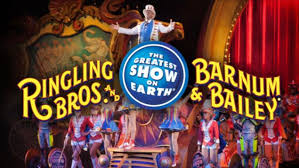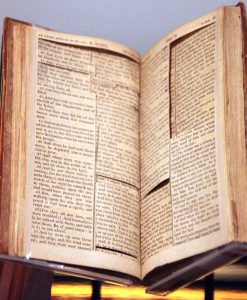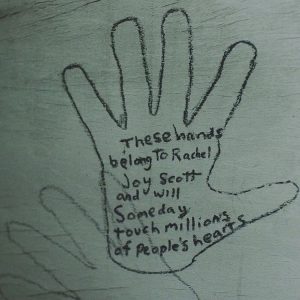In May 2017, a historic event happened: Ringling Brothers and Barnum and Bailey Circus shut down. Almost two centuries ago, it was created by the well-known P. T. Barnum. It had not started off as Ringling Brothers and Barnum and Bailey, or even Barnum and Bailey. It first started as a museum in New York City as the American Museum.

In 1841, Phineas Taylor Barnum purchased the Scudder’s Museum and renamed it the American Museum. He filled this with all different kinds of oddities, from a fabled 161-year-old woman named Joice Heth, who was supposed to have been George Washington’s slave, to a midget named General Tom Thumb, to a FeeJee mermaid, which was the upper half of a monkey sewn to the lower half of a fish.1 Barnum repeatedly fooled the public into believing his outrageous oddity claims, all for the purpose of making money for himself, and also to satisfy curiosities about the odder things in life. Barnum named himself the Prince of Humbug, and the public loved that even more than being duped.2
“The noblest art is that of making others happy.”3
In 1865, Barnum was elected to the Connecticut legislature as a Republican representative. He was noted saying “A human soul, ‘that God has created, and Christ died for,’ is not to be trifled with. It may tenant the body of a Chinaman, a Turk, an Arab, or a Hottentot – it is still an immortal spirit” during one of the sessions on the discussion of African American voting rights. Barnum was a Unionist who advocated for the right of African Americans to vote, despite his years of being a supporter of slavery.4 The same year he was elected as a representative, his first museum was burned down by Confederate sympathizers.5 He was determined not to fail. Barnum rebuilt in a different location, only for another fire to burn this museum down three years later, in 1868; but this time the cause was unknown.
Despite the huge setback, this was one of the stepping stones in creating Ringling Brothers and Barnum and Bailey Circus. Defeated by the fires and large loss of money, Barnum retired. In 1871, W. C. Coup convinced Barnum to step out of retirement and go on the road with a travelling circus, “P. P. T. Barnum’s Grand Traveling Museum, Menagerie, Caravan & Hippodrome.” By 1872, it was being called the “Greatest Show on Earth” by none other than Barnum himself, though the rest of the country believed it as well. For eight years, Barnum and Coup took the circus around the country.6

In 1880, Barnum took the next step in creating Barnum & Bailey. He met James A. Bailey, who owned the Great London Circus, and partnered with him to create “P.T. Barnum’s Greatest Show on Earth, And the Great London Circus, Sanger’s Royal British Menagerie and The Grand International Allied Shows United,” later shortened to Barnum and Bailey’s Circus.7 Bailey was a man happy to give Barnum the light and hide in the background, running the logistics of the circus, earning him the name “King of Circus Men.”8 Josephine Robinson described the two men in a statement: “Mr. Barnum was the advertiser, who loved the limelight, who rode around in the ring, and announced who he was. But Mr. Bailey was the business man, content to be invisible, demanding it in fact, and interested only in the success of the show.”9
Give the people the best—spare no expense doing it—and they’ll reward you greatly. – James A. Bailey10
In 1882, Barnum and Bailey purchased Jumbo, an elephant that they claimed to be the biggest in the world. Jumbo would bring in thousands of people until he was hit by a freight car in 1885, after which the circus was financially devastated. Instead of giving up on the Jumbo act, Barnum and Bailey displayed Jumbo’s skeleton. The show continued and achieved one of Barnum’s lifelong dreams, travelling to Europe, where the circus toured in 1889 for the winter months. In London, a multitude of shows were played, such as the Nero or The Destruction of Rome.11

In 1891, a shock came to the entertainment world: Phineas Taylor Barnum passed away at eighty-one years old in his home. His death left the circus to Bailey, who ran the circus for fifteen years, introducing new shows and acts such as Buffalo Bill’s Wild West Show.12 Shock hit the United States again when, in 1906, James A. Bailey passed away in his home from erysipelas.
In 1907, the Ringling Brothers purchased the circus from Bailey’s wife. The brothers ran the circus separately until 1919 when the circuses merged creating the famous Ringling Brothers and Barnum and Bailey Circus. The new circus traveled the United States until it was dismantled ninety-nine years later.
- Salem Press Encyclopedia, 2013, s.v. “First Modern American Circus,” by Geralyn Strecker. ↵
- P.T. Barnum, The autobiography of P.T Barnum:clerk, merchant, editor, & showman (England:Ward & Lock, 1855), 86. ↵
- P.T. Barnum, Life of P.T. Barnum (Buffalo: The Courier Company, 1888). ↵
- “The Lost Museum Archive,” P. T. Barnum’s Speech on “Negro Suffrage,” May 26, 1865 (excerpts) https://lostmuseum.cuny.edu/archive/p-t-barnums-speech-on-negro-suffrage-may-26. ↵
- John Headley, Confederate Operations in Canada and New York (Nabu Press, 2010): 327. ↵
- Margo DeMello, Encyclopedia of Body Adornment (Westport, Conn: Greenwood, 2007), 25-26. ↵
- “P.T. Barnums Greatest Show on Earth, and Great London Circus, Sangers Royal British Menagerie & Grand International Allied Shows,” The Library of Congress, 1879 https://www.loc.gov/item/99471610/. ↵
- “James A. Bailey, King Of Circus Men, is Dead. News Kept From Performers Till The Show Was Over. Widow Gets Circus Stock. Showman Died Of Erysipelas At His Country Home Near Mount Vernon After A Week’s Illness,” New York Times, April 12, 1906. ↵
- Linda Simon, The Greatest Shows on Earth: A History of the Circus (London, UK: Reaktion Books, 2014): 85. ↵
- A Pioneer Showman (Public Opinion Company: January 1, 1906), 486. ↵
- Ernest J. Albrecht, From Barnum & Bailey to Feld: The Creative Evolution of the Greatest Show on Earth (Jefferson, North Carolina: McFarland, 2014), 27. ↵
- Encyclopedia of World Biography, 2010, s.v. “Bailey, James Anthony,” by James Craddock. ↵



67 comments
Christopher Vasquez
After seeing the Greatest Showman, which was based on P.T. Barnum’s experiences, it is interesting to have been able to read the more active, political side of Barnum. I found it to be interesting that Barnum was initially pro-slavery, but then switched to a political advocate of African Americans. Although I am not sure what caused this switch, I am glad he was able to see the errors of his ways. Also, I did not know that their famous elephant, Jumbo, was killed by a freight car. Barnum’s perspective on what makes people unique and special is inspiring; in his eyes, entertainment, the art of making people happy, is the noblest art — I agree with this. Barnum left a legacy, and I am glad he was born to revolutionize the entertainment industry.
Lamont Traylor
I feel like no one can even bring up the thought of a circus without mentioning the Barnum and Bailey circus. I always thought that every circus was owned by them. I went to see their circus when I was a kid and I absolutely loved it. Seeing the elephants and acrobats flying through the air was something that seemed out of this world.
Micaela Cruz
I’ve never been a huge circus fan but I did express interest in seeing the movie, “The Greatest Showman,” in which this story was based on… I never went. Prior to reading this article, I was aware of how famous this circus was but what I didn’t know was all the background of the men who were in charge. To find out that it all started out as a museum and then ultimately turning into a worldwide sensation is extremely fascinating.
Valeria Perez
It is interesting to see the rest of the story that is not shown in the Greatest Showman. I would have never imagined that Barnum went into politics and that he would be against slavery.
I also appreciate how this article mentioned Mr. Bailey. Barnum was the public figure for the circus but it was Bailey who kept it going.
The story of this circus is a whirlwind, it is sad that they had to cancel it, I would have liked to see it.
Rebecca Campos
The circus was one of the classic childhood events while growing up. The story behind the circus is not common knowledge and I was fascinated to learn about the world PT Barnum designed and the lengths he went to in order to be successful. I was also unaware that he was a member of the legislature. The beginning statement could have been a little stronger, but the overall story was informative and I definitely learned some new things about the circus I had grown up with.
Raymond Munoz
Prior to reading this article the only knowledge I had of P.T. Barnum and the circus was the late 2017 movie ‘The Greatest Showman’. The movie highlights Barnum’s business side, while this article adequately describes how he brought the circus to life. Reading all the many transitions the circus made was a true pleasure and adding the quotes of Barnum and Bailey was a nice tool that added to the overall effect of the article. Overall this was an amazing, informative, and intriguing article!
Tyler Boyd
I remember going to this circus when I was a kid. It was an absolutely awe inspiring show for a child to see all of the different acts and animals. Reading this article was very interesting, I enjoyed getting a peak behind the curtain and seeing how the greatest show on earth came to be. It’s sad that it has since been dismantled, but it was probably time for it to end especially with the internet bringing all of the worlds oddities into your home.
Hannah Wilson
The circus is always a very captivating event with all of the colors and shows. I think that this article was well-written and well-researched. I thought it was interesting to read about where it all originated from and I thought that the pictures you chose helped make the reader more intrigues by the story. I really enjoyed reading this article about the Ringley Brother, great job.
Timothy ODekirk
It is so interesting how this is the start of the first circus ever created. In my opinion, I feel like the circus was something that was started long before the 1800s, like maybe in the 1700s or even earlier in places such as Europe. I just love the ideas of elephants and lion. I compare the classic circus to modern day rodeos how a lot of it is people performing with animals at their sides. This was a great article and was well worth the read.
Vanessa Tombo
The writer’s diction, syntax, tone and most importantly colorful images made this article very easy to read, understand and enjoy for me. This article was very informative, prior to reading it I had not known of P.T. Barnum or any aspect of his life. This article educated readers in a manner that is very enjoyable and easy to follow along.